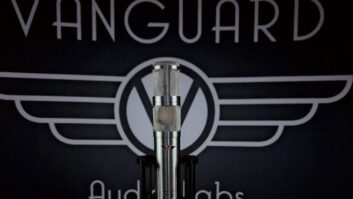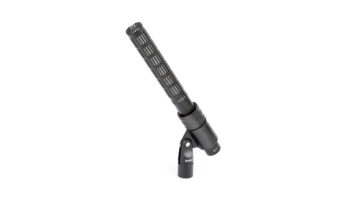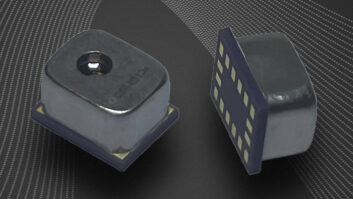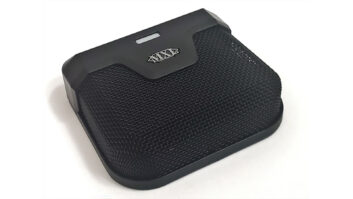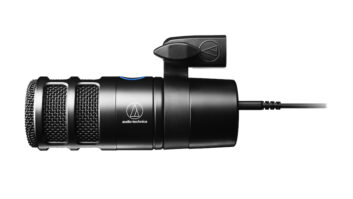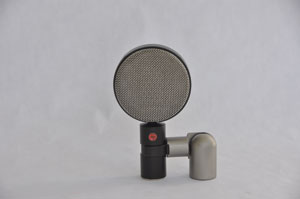
Since 1964, Coles has been manufacturing microphones and OEM speaker components for broadcast, studio and other uses. The 4038 is the company’s most popular and recognizable product, sporting its frying pan–styled head and magnets strong enough to pull in passing cars. Kidding aside, the 4030L’s ribbon is the same size and material as the 4038, but the mic employs different magnets that help tame the stray magnetism of the 4038. The 4030L is priced to bring Coles sound and quality to an affordable level. For this review, I had a pair of the 4030Ls and used them on a variety of applications.
Sweet Design
The 4030L’s sporty lollipop design and light weight are what I first noticed when taking it out of the box. It comes in a plastic case with a sturdy stand mount that makes the Coles easy to place. The mic is open at both ends sporting a figure-8 pattern, as you’d expect. One side of the mic has the blue Coles logo and the other a red badge. There was little documentation in the package or on the company’s Website, so I started using the mic with the logo side pointing toward the source and quickly found it to be out of polarity. A quick Galaxy cricket check confirmed that I was wrong and the red side is the front of the mic. I found this to be counterintuitive but whatever is right is right.
For the first application, I used a pair of 4030Ls over a great-sounding, four-piece maple Craviotto drum kit. The mics were placed a stick’s length above the crash and ride cymbal and presented the kit well just by themselves. The top frequencies of the cymbals were rolled off, as you’d expect from a ribbon, offering smooth transients without edgy spikes from the stick hits. The midrange frequencies, including tom and snare hits, were round and worked with the close-up snare and tom mics. Adding 4 to 6 dB at 10k from an API 550A added the top needed to make the 4030Ls a great pair of drum overheads. Later, we used one of the pair for a quick tambourine overdub and it again sounded great. The ribbon worked very well for hand percussion, exhibiting all the smoothness you’d expect.
The pair didn’t fare as well when used as room mics about 4 to 5 feet in front of another drum kit in a Blumlein pair. I tried this application on two occasions using a Moon 3500MP preamp, then a Millennia HV-35 500 Series preamp in Ribbon mode. With this setup, I had plenty of clean gain and was giving the mics the best shot possible. In both sessions the sound was papery, lacking punch. We ended up swapping them for Coles 4038s, which had much more finesse in this situation, offering better punch and bottom end. Over time, I found that the 4030Ls thrive, and offer better outcomes, when they’re challenged in very high-SPL applications.
Low Level, Low-Go
Next I tried the pair with the Moon preamp when recording an acoustic guitar. While the sound was good, the player’s soft finger-style playing was hampering the mic’s ability to produce enough level to push the mics to be at their best. The Moon, which has a ton of clean gain, was cranked and the meters on the tracks in Pro Tools still had plenty of headroom. This confirmed my feeling that these mics aren’t the best choice for low-level sources like acoustic guitar.
However, in front of a screaming guitar amp, the 4030Ls were in their element. I used a 4030L in front of a 4×12-inch Marshall cabinet powered by a JCM800 head. On two sessions I used the mic as a companion to a Royer 121 and then a Sennheiser 421, with great results on both occasions. The 121 and 4030L were respectively powered by Millennia HV-35 and Grace m501 preamps, both in Ribbon mode. The Royer offered more edge in the upper mids while the 4030L had an attractive midrange growl and nice low end. Together they were stellar. I had the same experience when using a 421 as a companion.
Without saying much about my own feelings, I lent the mics to Nashville engineer Mark Hagen and producer/guitarist Brandon Hood for a guitar overdub and they both confirmed my experience. They used the 4030L with a dynamic mic, and they paired up nicely. By the way, this is where this pair has it over the 4038s, which can hang 5 feet back from a drum kit but will melt if placed directly in front of a guitar cabinet as I tried here.
When used in the right applications, the Coles 4030L dynamic ribbon transducers sound great. They thrive in high-SPL environments, offering solid sonics, round transients, growly midrange and nice low-midrange. At this price, these mics would be a great pick for recording hand percussion, loud guitars or placed as drum overheads. You’ll need a quiet preamp with plenty of gain if you want to pull these back from a loud source or use them in a lower-level instrument recording application. The 4030Ls are a good and affordable choice for anyone wishing to have a Coles transducer in their arsenal of mics.
Kevin Becka is Mix’s technical editor.
Product Summary
COMPANY: Coles Electroacoustics
PRODUCT: 4030L
WEBSITE:www.coleselectroacoustics.com
PRICE: $1,563
PROS: Thrive in high-SPL environments. Great for recording close drums and loud guitar amps.
CONS: Doesn’t fare well for acoustic guitar or as a room mic.
Try This
When recording with passive ribbon mics, it’s always a good idea to match the mic and preamp to get the best results. Some preamp manufacturers make units with a ribbon mode that does a number of things. First, the ribbon mode provides more gain, which is always good when using a ribbon. Second, the phantom power is disabled so you can’t accidentally damage the mic. And third, it ups the input impedance so the mic always stays in the optimal impedance area below the input impedance of the preamp.


